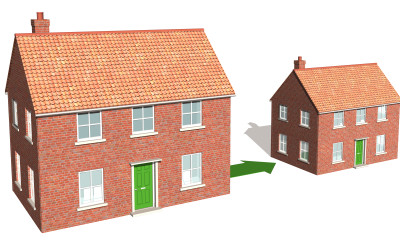
Size Doesn’t Matter in Small Spaces
Small spaces can be a challenge to decorate. The wrong color can feel claustrophobic, too much furniture can feel chaotic, and the wrong patterns just feel too busy. As so many of us are living in smaller space here are a few designer tricks to make a small space look larger than it is.
Don’t use dark colors.
Have you ever walked into a room painted a dark color with dark furnishings and a dark rug? It feels like the room is closing in on you. That’s the problem with dark colors and especially confining in a small room. A room needs to appear larger than it is to really feel comfortable. Using lighter colors will make walls appear to recede, creating a bright and airy feel. Good colors to consider are light blues, greens, light greys and neutrals.
Don’t be afraid to go bold.
Most people resist the idea of going bold in a small space, but smaller spaces are great places to experiment with bolder ideas. Start by keeping the color scheme to a few complimentary colors. Try using larger graphic prints, vertical or horizontal stripes. Horizontal stripes will visually widen a small narrow room. Vertical stripes will make a low ceiling seem taller. A room will open up with the use of big prints. Avoid smaller tiny prints; they will be too busy and chaotic in a small space. Experiment!
Scale and proportion.
Just like Goldie Locks looking for the right bed, one too big, one too small, and finally one was just right. Furniture needs to be just right in a smaller space. You want to use a mix of larger pieces along with smaller ones for balance.
Don’t use contrasting colors on the floors.
Your eye follows the floor up to the wall and then the ceiling. When they are the same colors, or tones you will see it as a continuous line. By keeping the three surfaces in the same color family the space will visually open up as they recede creating the illusion of more space.
Don’t clutter the room.
Clutter is not much different from dark walls when it comes to a small room. If you walk into a room crammed with furniture, overrun with knick-knacks and collectibles it will feel like it is closing in on you. To keep the room feel open chose a few cherished items and display them in a creative way. Less is more when furnishing a small space.
Don’t ignore traffic patterns.
So, you have the right scale furnishings, but you want to move around the space easily. A great trick is to float the furniture in the space. Move your sofa and chairs away from the wall. This will create depth in the space. You want to see a fair amount of the floor. The more floor that can be seen the larger the room will appear. Next, ground your furniture with an area rug in the same color tones as the flooring. You will visually open up the space.
Don’t forget lighting.
A small room with poor lighting will feel cave like. A properly lit room should have three sources of lighting that help bounce light off the walls and give the room a visual breath. Table lamps, floor lamps, natural light can help light a room. Another great trick is to use mirrors. A good mirror will do two things for a small room. It will reflect natural light and the light from lamps and it will create the illusion of a wider, deeper space.
Don’t use elaborate window treatments.
Small rooms can be overwhelmed with windows framed in full and billowy window treatments with a lot of pattern. Using elaborate windows draws attention to the windows instead of just accenting them. Pick window treatments that let light in and gently frame the windows. A simply style will gently blend harmoniously with a wall rather than visually breaking up the wall space.
Don’t discount architectural details.
Walls that lack interest are boring, but can be exciting with the addition of a few architectural details. Wainscoting and crown moldings are beautiful and affordable options. They define small spaces well and add visual interest to otherwise dull walls.
Don’t ignore vertical space.
Once everything is in place, you may realize you have no room for storage and no floor space to add anything. The walls are still there and they are not just for artwork. Take advantage of vertical space the walls offer, look at it as extra square footage. They can be perfect for hanging shelves, or buildt-ins.
When it comes to decorating small spaces, it’s all about tricking the eye to believe that the space is much larger. Try one or several of these tips and tricks the next time you are decorating a small space
Design is everything.
EVERYTHING!
Todd
______________________________________________________________________________
About the Author:
Todd Russell was a professional Interior Designer with over 20 years
experience in helping couples create unique living spaces.




